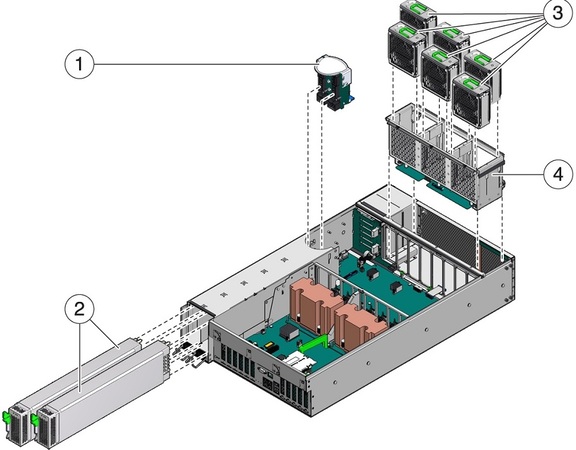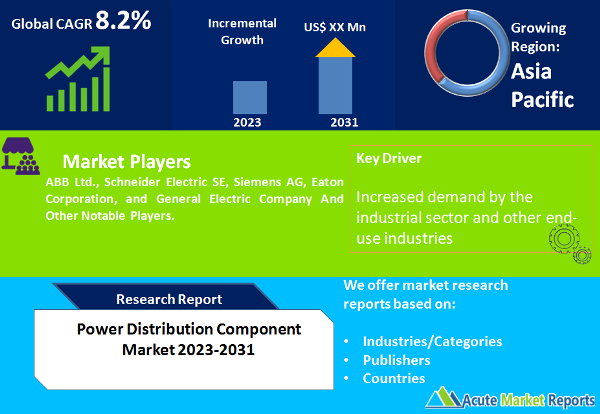
The power distribution component market refers to the industry involved in the manufacturing and supply of various components used in power distribution systems. The power distribution component market is expected to grow at a CAGR of 8.2% during the forecast period of 2025 to 2033. These components are crucial for transmitting and distributing electrical power efficiently and safely. The market has witnessed steady growth in recent years, driven by the increasing demand for electricity, the expansion of power infrastructure, and the need for reliable and efficient power distribution networks. In terms of market revenue, the power distribution component market has experienced steady growth. The increasing electrification initiatives across sectors such as residential, commercial, and industrial have contributed to the rise in demand for power distribution components. Additionally, the growing focus on renewable energy sources and the integration of smart grid technologies have further propelled the market. The revenue generated from the sales of power distribution components, including transformers, switchgear, circuit breakers, distribution boards, and meters, has been substantial, reflecting the importance of these components in the power distribution ecosystem. The market's CAGR highlights the sustained growth and potential for further expansion. Factors driving the high CAGR include the increasing need for upgrading aging power infrastructure, government initiatives promoting the development of smart cities and grid modernization, and the integration of advanced technologies such as digital monitoring and automation in power distribution systems.

Increasing Energy Demand and Infrastructure Development
The power distribution component market is driven by the growing global energy demand and the need for robust power infrastructure. As economies expand, industries grow, and urbanization accelerates, the demand for electricity continues to rise. This necessitates the development of efficient power distribution networks and the deployment of advanced components. Rapid urbanization in developing countries has led to a surge in electricity consumption. The need for reliable power distribution systems to meet the rising energy demand in urban areas drives the demand for power distribution components. Industrial sectors, such as manufacturing, mining, and construction, require a substantial power supply for their operations. As industrial activities expand, there is a corresponding increase in demand for power distribution components to ensure efficient power distribution and supply to these sectors.
Renewable Energy Integration and Grid Modernization
The integration of renewable energy sources into the power grid and the modernization of existing grid infrastructure are key drivers of the power distribution component market. The transition towards cleaner and more sustainable energy sources necessitates the adoption of new technologies and components that can effectively manage the distribution of renewable energy. Governments worldwide are setting ambitious renewable energy targets to reduce carbon emissions and combat climate change. The integration of renewable energy sources, such as solar and wind, into the power grid requires advanced power distribution components to manage the intermittent nature of these energy sources. Grid modernization initiatives, such as the implementation of smart grids, aim to improve the efficiency, reliability, and flexibility of power distribution networks. Smart grid technologies rely on advanced power distribution components, including smart meters, sensors, and automation systems, to enable real-time monitoring, control, and optimization of power flow.
Technological Advancements and Digitalization
Technological advancements and the digitalization of power distribution systems are driving the demand for innovative power distribution components. The integration of digital technologies, such as IoT, data analytics, and automation, is transforming the way power is distributed and managed, requiring new components that can support these advanced functionalities. IoT technologies are being deployed in power distribution systems for real-time monitoring, predictive maintenance, and load management. Power distribution components with IoT capabilities, such as smart sensors and communication modules, are in demand to enable these applications. Data analytics and automation are being employed to optimize power distribution networks, improve energy efficiency, and enhance grid resilience. Power distribution components with built-in analytics capabilities and automation features enable efficient control and optimization of power flow.
High Initial Investment and Infrastructure Constraints
The power distribution component market faces the challenge of high initial investment requirements and infrastructure constraints that can hinder market growth and adoption. Implementing power distribution systems and upgrading existing infrastructure requires significant capital investment, which can be a deterrent for many organizations, particularly in developing regions. The cost associated with the installation, integration, and maintenance of power distribution components, such as transformers, switchgear, and meters, can be substantial. Additionally, infrastructure constraints, such as limited grid connectivity in remote areas or inadequate power infrastructure in underdeveloped regions, pose challenges for the widespread adoption of power distribution components. These constraints may limit the deployment of advanced power distribution technologies and impede the expansion of the market. The high upfront costs associated with power distribution components, including procurement, installation, and system integration, can be a significant restraint for organizations, particularly small and medium-sized enterprises with limited financial resources. In regions with inadequate power infrastructure or limited grid connectivity, the implementation of power distribution components may be constrained. These infrastructure limitations can pose challenges in extending power distribution networks and hinder the adoption of advanced components in certain areas.
Switchgear Leading the Product Segment
In the power distribution component market, various product segments contribute to the overall revenue and exhibit different growth rates. Among the product segments, switchgear, switchboard, distribution panel, motor control panel, and others play key roles in facilitating the efficient distribution of electrical power. Switchgear, comprising components such as circuit breakers, fuses, and disconnect switches, held a significant share in terms of revenues in 2024. Switchgear is essential for protecting electrical circuits from overloads, short circuits, and other faults, ensuring the safe and reliable operation of power distribution systems. The increasing demand for a reliable and secure power supply, coupled with the need to upgrade aging power infrastructure, drives the growth of the switchgear segment. However, the motor control panel segment is expected to demonstrate a higher CAGR during the forecast period of 2025 to 2033, owing to industrial growth, infrastructure development, and increasing automation, leading to higher demand for motor control solutions.
Fixed Mounting Configurations Dominate the Market by Configuration
In the power distribution component market, the configuration segment plays a crucial role in determining the revenue and growth potential of different configurations used in power distribution systems. Fixed mounting configurations, where the components are permanently installed and cannot be easily removed or replaced, contributed significantly to the market's revenue in 2024. These configurations are widely used in power distribution systems due to their reliability and cost-effectiveness. Fixed mounting configurations are commonly employed in applications where frequent changes or modifications to the system are not required. Plug-in configurations, characterized by their modular design and ease of installation, are expected to exhibit a higher CAGR during the forecast period of 2025 to 2033, compared to other configurations. The plug-in configuration allows for quick and convenient installation, removal, and replacement of components without interrupting the power supply. This flexibility and ease of maintenance contribute to the growing adoption of plug-in configurations in power distribution systems, driving their higher CAGR.
APAC Remains as the Global Leader
Asia-Pacific led in terms of revenue generation in 2024 and is also expected to lead with respect to expected CAGR during the forecast period of 2025 to 2033, fueled by rapid industrialization and infrastructure development. The region's rapid industrialization, urbanization, and increasing energy demand have driven the adoption of power distribution components. Countries like China and India, with their massive populations and extensive infrastructure projects, have been key contributors to the region's revenue growth. Additionally, government initiatives promoting renewable energy, smart grid infrastructure, and urban development have further boosted the demand for power distribution components in the region. North America, with its well-established power infrastructure, has also witnessed significant revenue generation in the power distribution component market. The region's emphasis on grid modernization, renewable energy integration, and infrastructure upgrades has fueled the demand for advanced power distribution components. Furthermore, the presence of major market players and technological advancements in the region contribute to its revenue growth.
Product Innovation to Remain as the Key to Enhance Market Share
The power distribution component market is highly competitive, with several key players striving to establish their dominance and capture a significant market share. These companies employ various strategies to gain a competitive edge, including product innovation, partnerships, mergers and acquisitions, and geographical expansions. Some of the top players in the power distribution component market include ABB Ltd., Schneider Electric SE, Siemens AG, Eaton Corporation, and General Electric Company. These companies have a strong presence in the market and offer a wide range of power distribution components catering to diverse customer requirements. Product innovation is a key strategy adopted by these players to stay ahead in the competitive landscape. They invest significantly in research and development to develop advanced and efficient power distribution components. These innovations focus on enhancing the reliability, energy efficiency, and safety features of the components. Additionally, companies are integrating digital technologies and smart functionalities into their products to meet the growing demand for intelligent power distribution solutions. Partnerships and collaborations play a crucial role in expanding market reach and strengthening the product portfolio. Power distribution component manufacturers often collaborate with technology providers, system integrators, and utility companies to offer comprehensive solutions and tap into new market opportunities. By leveraging their collective expertise, these partnerships enable companies to deliver integrated solutions that address the evolving needs of customers.
Historical & Forecast Period
This study report represents analysis of each segment from 2023 to 2033 considering 2024 as the base year. Compounded Annual Growth Rate (CAGR) for each of the respective segments estimated for the forecast period of 2025 to 2033.
The current report comprises of quantitative market estimations for each micro market for every geographical region and qualitative market analysis such as micro and macro environment analysis, market trends, competitive intelligence, segment analysis, porters five force model, top winning strategies, top investment markets, emerging trends and technological analysis, case studies, strategic conclusions and recommendations and other key market insights.
Research Methodology
The complete research study was conducted in three phases, namely: secondary research, primary research, and expert panel review. key data point that enables the estimation of Power Distribution Component market are as follows:
Market forecast was performed through proprietary software that analyzes various qualitative and quantitative factors. Growth rate and CAGR were estimated through intensive secondary and primary research. Data triangulation across various data points provides accuracy across various analyzed market segments in the report. Application of both top down and bottom-up approach for validation of market estimation assures logical, methodical and mathematical consistency of the quantitative data.
| ATTRIBUTE | DETAILS |
|---|---|
| Research Period | 2023-2033 |
| Base Year | 2024 |
| Forecast Period | 2025-2033 |
| Historical Year | 2023 |
| Unit | USD Million |
| Segmentation | |
Product
| |
Configuration
| |
By Insulation
| |
Installation
| |
Application
| |
|
Region Segment (2023-2033; US$ Million)
|
Key questions answered in this report